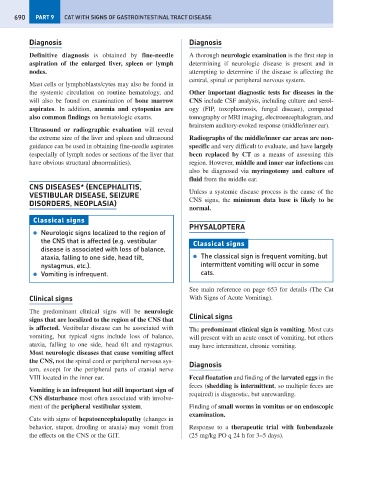Page 698 - Problem-Based Feline Medicine
P. 698
690 PART 9 CAT WITH SIGNS OF GASTROINTESTINAL TRACT DISEASE
Diagnosis Diagnosis
Definitive diagnosis is obtained by fine-needle A thorough neurologic examination is the first step in
aspiration of the enlarged liver, spleen or lymph determining if neurologic disease is present and in
nodes. attempting to determine if the disease is affecting the
central, spinal or peripheral nervous system.
Mast cells or lymphoblasts/cytes may also be found in
the systemic circulation on routine hematology, and Other important diagnostic tests for diseases in the
will also be found on examination of bone marrow CNS include CSF analysis, including culture and serol-
aspirates. In addition, anemia and cytopenias are ogy (FIP, toxoplasmosis, fungal disease), computed
also common findings on hematologic exams. tomography or MRI imaging, electroencephalogram, and
brainstem auditory-evoked response (middle/inner ear).
Ultrasound or radiographic evaluation will reveal
the extreme size of the liver and spleen and ultrasound Radiographs of the middle/inner ear areas are non-
guidance can be used in obtaining fine-needle aspirates specific and very difficult to evaluate, and have largely
(especially of lymph nodes or sections of the liver that been replaced by CT as a means of assessing this
have obvious structural abnormalities). region. However, middle and inner ear infections can
also be diagnosed via myringotomy and culture of
fluid from the middle ear.
CNS DISEASES* (ENCEPHALITIS,
VESTIBULAR DISEASE, SEIZURE Unless a systemic disease process is the cause of the
DISORDERS, NEOPLASIA) CNS signs, the minimum data base is likely to be
normal.
Classical signs
PHYSALOPTERA
● Neurologic signs localized to the region of
the CNS that is affected (e.g. vestibular
Classical signs
disease is associated with loss of balance,
ataxia, falling to one side, head tilt, ● The classical sign is frequent vomiting, but
nystagmus, etc.). intermittent vomiting will occur in some
● Vomiting is infrequent. cats.
See main reference on page 653 for details (The Cat
Clinical signs With Signs of Acute Vomiting).
The predominant clinical signs will be neurologic
Clinical signs
signs that are localized to the region of the CNS that
is affected. Vestibular disease can be associated with The predominant clinical sign is vomiting. Most cats
vomiting, but typical signs include loss of balance, will present with an acute onset of vomiting, but others
ataxia, falling to one side, head tilt and nystagmus. may have intermittent, chronic vomiting.
Most neurologic diseases that cause vomiting affect
the CNS, not the spinal cord or peripheral nervous sys-
Diagnosis
tem, except for the peripheral parts of cranial nerve
VIII located in the inner ear. Fecal floatation and finding of the larvated eggs in the
feces (shedding is intermittent, so multiple feces are
Vomiting is an infrequent but still important sign of
required) is diagnostic, but unrewarding.
CNS disturbance most often associated with involve-
ment of the peripheral vestibular system. Finding of small worms in vomitus or on endoscopic
examination.
Cats with signs of hepatoencephalopathy (changes in
behavior, stupor, drooling or ataxia) may vomit from Response to a therapeutic trial with fenbendazole
the effects on the CNS or the GIT. (25 mg/kg PO q 24 h for 3–5 days).

